Crocodile Peptide Market
Crocodile Peptide Market Size and Share Forecast Outlook 2025 to 2035
Crocodile peptide market is projected to grow from USD 140.0 billion in 2025 to USD 290.0 billion by 2035, at a CAGR of 7.6%. Nutraceutical will dominate with a 56.0% market share, while powder will lead the form segment with a 64.0% share.
Crocodile Peptide Market Forecast and Outlook 2025 to 2035
The global crocodile peptide market is valued at USD 140.0 million in 2025. It is slated to reach USD 290.0 million by 2035, recording an absolute increase of USD 150.0 million over the forecast period. This translates into a total growth of 107.1%, with the market forecast to expand at a CAGR of 7.6% between 2025 and 2035.
The market is expected to grow by nearly 2.07X during the same period, supported by increasing research on bioactive peptides, growing demand for exotic protein sources, expanding applications in nutraceutical and cosmetic industries, and rising consumer interest in premium functional ingredients.
Quick Stats for Crocodile Peptide Market
- Crocodile Peptide Market Value (2025): USD 140.0 million
- Crocodile Peptide Market Forecast Value (2035): USD 290.0 million
- Crocodile Peptide Market Forecast CAGR: 7.6%
- Leading Grade Type in Crocodile Peptide Market: Nutraceutical
- Key Growth Regions in Crocodile Peptide Market: North America, Europe, and Asia-Pacific
- Key Players in Crocodile Peptide Market: Crocodile Gold Peptide Co., Shaanxi GreenBio, Rishon Biochem, Lonza, Givaudan, BioCell
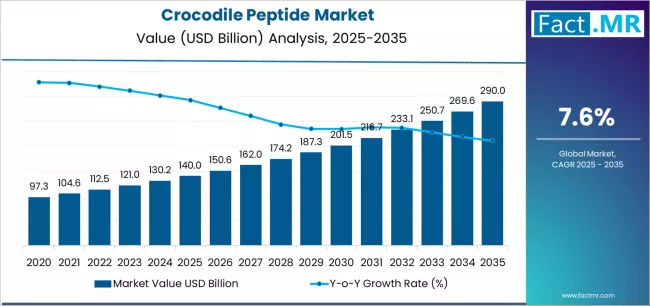
The growing prevalence of lifestyle-related health concerns is driving heightened interest in bioactive compounds, including crocodile peptides, for their therapeutic and functional properties. Crocodile peptides are increasingly recognized for their antioxidant, antimicrobial, and anti-inflammatory activities, which position them as highly valuable ingredients in the nutraceutical and cosmeceutical sectors.
Research efforts focused on elucidating their molecular mechanisms are accelerating, prompting innovations in product formulations that target skin regeneration, wound healing, and immune system support. Academic institutions, biotechnology firms, and cosmetic companies are actively investing in studies to optimize extraction techniques and enhance peptide purity, ensuring consistent quality for end-use applications.
Consumer preference for exotic proteins and bioactive ingredients is also reshaping the market landscape. Crocodile peptides offer a unique differentiation factor compared to traditional protein sources, appealing to health-conscious and premium-seeking segments. Their adoption is rising across functional beverages, dietary supplements, and skincare products, particularly in regions with high disposable income and growing awareness of bioactive benefits.
Cosmetic companies are integrating crocodile peptides into anti-aging serums, moisturizers, and healing ointments, leveraging their regenerative and collagen-stimulating properties. This trend is expected to support premium pricing strategies, driving revenue growth in both established and emerging markets.
Regulatory frameworks and sustainable sourcing practices are becoming critical factors in market development. Companies are focusing on ethical sourcing of crocodile by-products and developing processes that comply with international standards for safety, animal welfare, and environmental impact.
Innovations in biotechnology are enabling more efficient peptide extraction and synthesis, reducing reliance on natural sources while meeting growing demand. This convergence of sustainability and technological advancement is likely to expand the supply base and improve scalability across global markets.
North America and Asia-Pacific are emerging as key growth hubs. Rising consumer awareness, coupled with a robust nutraceutical industry in the United States, is driving strong market uptake. In Asia-Pacific, markets such as China, Japan, and South Korea are witnessing rapid adoption due to increasing consumer spending on functional foods, skincare, and premium supplements. Europe is expected to maintain steady growth, with regulatory compliance and research-driven product innovation acting as key enablers.
The market’s expansion is also supported by collaborations between biotechnology firms, research institutions, and cosmetic companies to develop high-value formulations. Patent filings, clinical trials, and product launches are creating competitive differentiation while driving awareness among consumers and healthcare professionals.
Investment in marketing campaigns highlighting efficacy and safety is further strengthening demand. Over the forecast period, the convergence of research, innovation, and premiumization is expected to make crocodile peptides a mainstream ingredient, contributing to the projected 2.07X market growth by 2035.
Between 2025 and 2030, the crocodile peptide market is projected to expand from USD 140.0 million to USD 210.0 million, resulting in a value increase of USD 70.0 million, which represents 46.7% of the total forecast growth for the decade.
This phase of development will be shaped by increasing research validation of bioactive properties, growing premium nutraceutical market, and expanding applications in anti-aging and immune support products. Peptide manufacturers and ingredient suppliers are expanding their crocodile peptide capabilities to address the growing demand for exotic and high-value functional ingredients.
Crocodile Peptide Market Key Takeaways
| Metric | Value |
|---|---|
| Estimated Value in (2025E) | USD 140.0 million |
| Forecast Value in (2035F) | USD 290.0 million |
| Forecast CAGR (2025 to 2035) | 7.6% |
From 2030 to 2035, the market is forecast to grow from USD 210.0 million to USD 290.0 million, adding another USD 80.0 million, which constitutes 53.3% of the overall ten-year expansion.
This period is expected to be characterized by the expansion of commercial production capabilities, development of standardized extraction methods, and growth of premium cosmetic applications targeting anti-aging and skin health benefits. The growing adoption of exotic peptide ingredients and luxury wellness products will drive demand for crocodile peptides with enhanced purity and bioactivity profiles.
Between 2020 and 2025, the crocodile peptide market experienced significant growth, driven by increasing research on unique bioactive properties and growing recognition of crocodile peptides as premium functional ingredients for health and cosmetic applications.
The market developed as nutraceutical companies and cosmetic manufacturers recognized the potential for crocodile peptide technology to provide differentiated product benefits, support premium positioning, and meet consumer demand for exotic and high-performance ingredients.
Why is the Crocodile Peptide Market Growing?
Market expansion is being supported by the increasing consumer interest in exotic and premium functional ingredients driven by wellness trends and luxury product positioning, alongside the corresponding need for high-value bioactive peptides that can provide unique health benefits, anti-aging properties, and immune system support across various nutraceutical and cosmetic applications.
Modern ingredient suppliers and product manufacturers are increasingly focused on implementing crocodile peptide solutions that can differentiate products, command premium pricing, and provide scientifically validated health benefits while maintaining quality standards and regulatory compliance.
The growing emphasis on premium wellness and anti-aging solutions is driving demand for crocodile peptides that can support skin health enhancement, immune function optimization, and ensure comprehensive bioactive benefits through unique amino acid profiles and peptide sequences.
Manufacturers' preference for ingredients that combine exotic appeal with scientific validation and proven efficacy is creating opportunities for innovative crocodile peptide implementations. The rising influence of personalized nutrition and luxury wellness trends is also contributing to increased adoption of crocodile peptides that can provide superior bioactivity without compromising safety or regulatory acceptance.
Segmental Analysis
The market is segmented by grade, form, and distribution channel. By grade, the market is divided into nutraceutical, cosmetic, and research/others. Based on form, the market is categorized into powder and liquid formulations. By distribution channel, the market is segmented into B2B ingredient, online, and specialty channels.
By Grade, Nutraceutical Segment Leads the Market
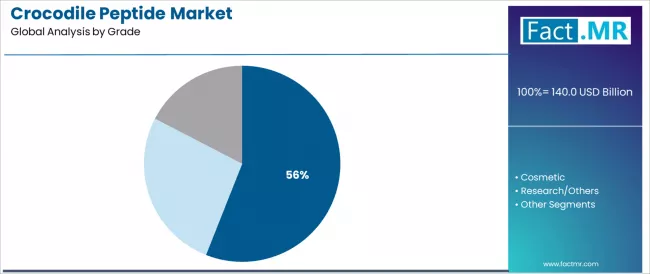
The nutraceutical segment is projected to maintain its leading position in the crocodile peptide market in 2025, capturing a 56.0% share, reflecting its dominant role in health and wellness applications. Manufacturers and supplement companies increasingly leverage crocodile peptides for their distinctive bioactive properties, premium positioning potential, and demonstrated effectiveness in supporting immune function and overall health. This segment addresses industry demands for innovative, functional ingredients that enhance product differentiation and appeal to health-conscious consumers.
As the foundation of modern exotic peptide utilization, nutraceutical applications contribute the greatest market value and enjoy widespread consumer acceptance across multiple health benefit categories and premium product segments. Continued investments in exotic peptide technologies further strengthen adoption among manufacturers, aligning with evolving consumer preferences for scientifically validated, premium wellness ingredients. Crocodile peptides, therefore, occupy a central role in comprehensive nutraceutical strategies, combining wellness efficacy with product differentiation.
By Form, Powder Segment Dominates Market Demand
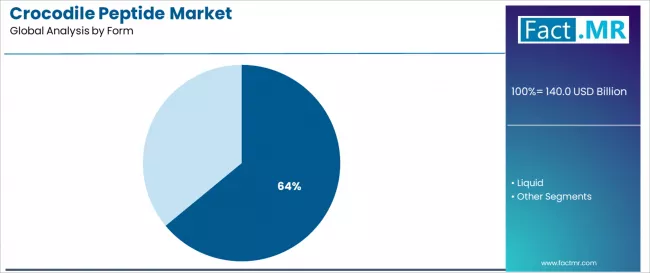
The powder form segment is projected to hold the largest share of crocodile peptide demand in 2025, with a 64.0% market share, emphasizing its critical role in ingredient processing and product formulation. Manufacturers favor powder forms due to superior stability, extended shelf life, and reliable bioactivity retention, supporting diverse formulation needs and manufacturing processes. Powder formats offer both handling convenience and quality preservation advantages, making them essential for high-value peptide applications.
Ongoing innovation in peptide processing technologies and the development of specialized powder formulations enable enhanced product integration, stability, and bioactivity retention. Ingredient manufacturers are investing in advanced powder processing programs to meet sophisticated formulation requirements and evolving market expectations. As processing technologies evolve and formulations grow more complex, the powder segment is set to continue dominating the market, driving both product quality optimization and advanced application strategies.
What are the Drivers, Restraints, and Key Trends of the Crocodile Peptide Market?
The crocodile peptide market is advancing rapidly due to increasing consumer interest in exotic and premium functional ingredients driven by wellness trends and luxury positioning, alongside growing demand for unique bioactive peptides that provide differentiated health benefits, anti-aging properties, and immune system support across various nutraceutical and cosmetic applications.
However, the market faces challenges, including limited raw material supply and sustainability concerns, high production costs and complex extraction processes, and regulatory uncertainties for novel exotic ingredients. Innovation in sustainable sourcing methods and extraction technology continues to influence product availability and market expansion patterns.
Expansion of Premium Wellness and Anti-Aging Markets
The growing premium wellness market is driving demand for crocodile peptides that can provide unique anti-aging benefits, immune system enhancement, and superior bioactivity through exotic protein sources and specialized amino acid profiles not available in conventional peptide ingredients.
Health-conscious consumers require advanced crocodile peptide formulations that deliver premium wellness results across multiple health parameters while maintaining luxury positioning and scientific validation.
Nutraceutical brands are increasingly recognizing the competitive advantages of crocodile peptide integration for product differentiation and premium market positioning, creating opportunities for specialized ingredients designed for high-value wellness applications and luxury health products.
Integration of Scientific Research and Bioactivity Validation
Modern crocodile peptide manufacturers are incorporating scientific research programs and bioactivity validation studies to enhance product credibility, support health claims, and ensure comprehensive quality assurance through clinical testing and efficacy documentation.
Leading companies are developing research partnerships, implementing clinical validation programs, and advancing analytical methods that demonstrate crocodile peptide benefits while maintaining regulatory compliance.
These research initiatives improve market acceptance while enabling new application opportunities, including pharmaceutical research, specialized therapeutic applications, and evidence-based wellness products.
Development of Sustainable Sourcing and Production Methods
The expansion of sustainable sourcing initiatives and ethical production methods is driving demand for responsibly obtained crocodile peptides through controlled farming operations, waste utilization programs, and sustainable processing technologies that address environmental concerns and ethical considerations.
These sustainable production approaches require specialized sourcing capabilities and quality control systems that exceed traditional ingredient procurement requirements, creating differentiated market segments with enhanced sustainability credentials.
Manufacturers are investing in sustainable sourcing partnerships and ethical production methods to serve environmentally conscious applications while supporting innovation in responsible ingredient development and sustainable luxury products.
Analysis of the Crocodile Peptide Market by Key Countries
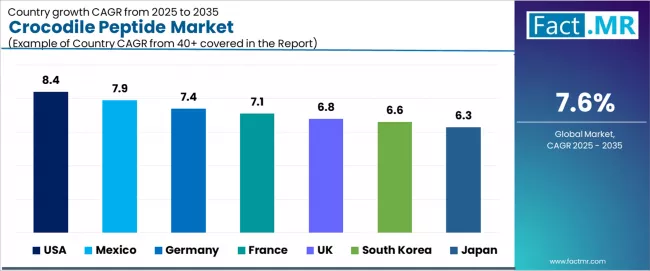
| Country | CAGR (2025-2035) |
|---|---|
| USA | 8.4% |
| Mexico | 7.9% |
| Germany | 7.4% |
| France | 7.1% |
| UK | 6.8% |
| South Korea | 6.6% |
| Japan | 6.3% |
The global crocodile peptide market is witnessing strong growth, led by the USA at an 8.4% CAGR through 2035, driven by a robust premium nutraceutical sector, advanced research capabilities, and heightened consumer demand for exotic functional ingredients fueling peptide innovation. Mexico follows closely with a 7.9% CAGR, supported by a growing luxury wellness market, expanding nutraceutical industry, and increased accessibility of premium health products.
Germany is anticipated to register 7.4% growth, underpinned by scientific validation, stringent quality standards, and advanced biotechnology applications. France demonstrates a 7.1% CAGR, propelled by its luxury cosmetics industry, premium wellness trends, and innovation in anti-aging products. The UK is projected to expand at a CAGR of 6.8%, fueled by premium health products, innovative ingredient development, and the expansion of luxury wellness markets.
South Korea is slated to achieve a 6.6% CAGR, driven by applications in premium beauty and wellness products, while Japan grows at 6.3%, supported by a strong preference for high-quality ingredients and advanced health product development initiatives.
USA Leads Global Market Growth with Premium Nutraceutical Innovation
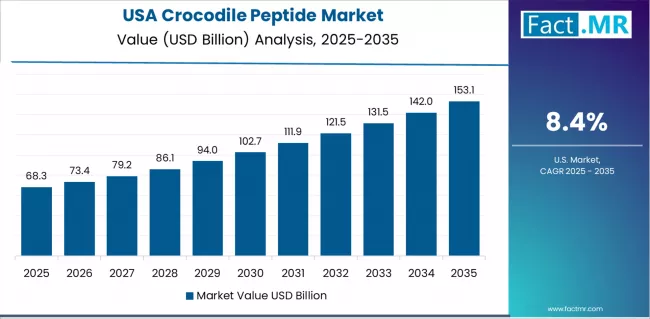
Revenue from the crocodile peptides market in the USA is projected to exhibit exceptional growth with a CAGR of 8.4% through 2035, driven by extensive premium nutraceutical market development and rapidly growing consumer interest in exotic functional ingredients supporting peptide innovation among wellness brands, supplement manufacturers, and cosmetic companies.
The country's advanced research infrastructure and increasing consumer willingness to pay premium prices for unique ingredients are creating substantial demand for crocodile peptide solutions. Major ingredient suppliers and nutraceutical companies are establishing comprehensive research and development capabilities to serve both domestic markets and export opportunities.
- Strong premium wellness culture and exotic ingredient interest are driving demand for crocodile peptides throughout high-end supplement manufacturers, luxury cosmetic brands, and specialty ingredient suppliers across urban markets and affluent consumer segments.
- Growing research capabilities and bioactive peptide innovation are supporting the rapid development of advanced crocodile peptide applications among companies seeking product differentiation and competitive advantages in the premium wellness market.
Mexico Demonstrates Strong Market Potential with Luxury Wellness Expansion
Revenue from the crocodile peptides market in Mexico is expanding at a CAGR of 7.9%, supported by the country's growing luxury wellness market, expanding nutraceutical industry, and increasing consumer interest in premium health products and exotic functional ingredients.
The country's evolving wellness culture and premium product appreciation are driving demand for sophisticated crocodile peptide applications throughout urban centers and affluent consumer markets. Leading ingredient suppliers and wellness brands are establishing comprehensive distribution networks to address growing demand for premium functional ingredients.
- Rising affluent consumer base and expanding luxury wellness culture are creating opportunities for crocodile peptide adoption across premium supplement manufacturers, high-end cosmetic brands, and specialty wellness retailers in major urban markets.
- Growing nutraceutical industry development and premium ingredient demand are driving adoption of exotic peptide ingredients among manufacturers seeking product differentiation and luxury positioning in competitive wellness markets.
Germany Demonstrates Scientific Excellence with Biotechnology Focus
Revenue from the crocodile peptides market in Germany is expanding at a CAGR of 7.4%, driven by the country's emphasis on scientific validation, advanced biotechnology capabilities, and comprehensive quality standards supporting evidence-based exotic ingredient development.
Germany's biotechnology expertise and regulatory rigor are driving demand for scientifically validated crocodile peptide solutions. Leading biotechnology companies and ingredient manufacturers are establishing comprehensive research programs for premium peptide development.
- Advanced biotechnology standards and consumer preference for scientifically validated ingredients are creating demand for research-backed crocodile peptides among premium nutraceutical manufacturers seeking evidence-based product differentiation and quality assurance.
- Strong regulatory framework and scientific research emphasis are supporting the adoption of clinically validated crocodile peptide formulations across high-end wellness brands and pharmaceutical research applications throughout major biotechnology regions.
France Focuses on Luxury Cosmetics and Anti-Aging Innovation
Revenue from the crocodile peptides market in France is expanding at a CAGR of 7.1%, driven by the country's renowned luxury cosmetics industry, premium anti-aging market, and comprehensive approach to beauty and wellness innovation supporting crocodile peptide integration into high-end skincare and cosmetic applications.
France's luxury beauty expertise and premium positioning culture are supporting investment in exotic peptide technologies. Major cosmetic companies and luxury brands are establishing comprehensive innovation programs incorporating crocodile peptides with French beauty traditions.
- Advanced luxury cosmetics standards and consumer preference for premium anti-aging ingredients are creating demand for crocodile peptides throughout high-end skincare manufacturers, luxury beauty brands, and prestige cosmetic retailers serving affluent consumer segments.
- Strong beauty culture and innovation leadership are driving the adoption of exotic peptide ingredients meeting high efficacy standards and luxury positioning requirements across diverse premium cosmetic applications.
UK Shows Market Leadership with Premium Ingredient Innovation
Revenue from the crocodile peptides market in the UK is expanding at a CAGR of 6.8%, supported by the country's premium health product market, innovative ingredient development culture, and growing interest in luxury wellness and exotic functional ingredients supporting crocodile peptide adoption across nutraceutical and cosmetic applications.
The UK's wellness innovation trends and premium product appreciation are driving demand for advanced crocodile peptide solutions. Leading wellness brands and ingredient companies are investing in premium product development and luxury positioning strategies.
- Advanced premium wellness culture and consumer interest in innovative ingredients are creating opportunities for crocodile peptides throughout luxury supplement brands, high-end cosmetic manufacturers, and specialty wellness retailers serving premium consumer segments.
- Strong ingredient innovation focus and luxury positioning trends are driving the adoption of exotic peptide ingredients across premium wellness products, luxury cosmetics, and specialized health applications targeting affluent consumers.
South Korea Demonstrates Beauty Leadership with Premium Applications
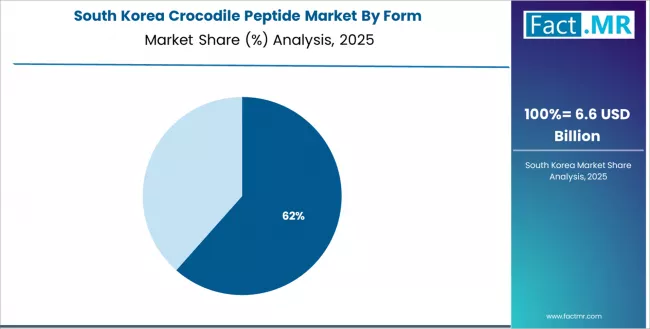
Revenue from the crocodile peptides market in South Korea is expanding at a CAGR of 6.6%, supported by the country's advanced beauty industry, premium wellness culture, and strong emphasis on high-performance cosmetic ingredients and anti-aging solutions supporting exotic peptide adoption.
The nation's beauty innovation and premium positioning trends are driving demand for sophisticated crocodile peptide solutions. Leading beauty companies are investing extensively in premium ingredient development and luxury market expansion.
- Advanced beauty culture and premium cosmetic ingredient demand are creating demand for crocodile peptides throughout high-end skincare manufacturers, luxury beauty brands, and premium wellness retailers serving beauty-conscious consumer segments.
- Strong anti-aging focus and premium positioning trends are supporting the adoption of exotic peptide ingredients designed for advanced skincare applications and luxury beauty products across diverse consumer demographics.
Japan Shows Premium Focus with Quality-Driven Applications

Revenue from the crocodile peptides market in Japan is expanding at a CAGR of 6.3%, supported by the country's high-quality ingredient preferences, advanced health product development capabilities, and strong emphasis on premium wellness and anti-aging solutions supporting crocodile peptide adoption for specialized health applications.
Japan's quality consciousness and premium positioning focus are driving demand for superior crocodile peptide products. Leading health companies are investing in specialized capabilities for premium ingredient applications and quality-driven product development.
- Advanced quality standards and premium ingredient focus are creating opportunities for crocodile peptides throughout high-end supplement manufacturers, luxury cosmetic brands, and premium wellness retailers serving quality-conscious consumers seeking superior ingredients.
- Strong anti-aging culture and premium positioning emphasis are driving adoption of exotic peptide formulations meeting Japanese consumer expectations for efficacy, purity, and comprehensive health benefits across diverse premium applications.
Europe Market Split by Country

The crocodile peptide market in Europe is projected to expand from USD 42.0 million in 2025 to USD 85.0 million by 2035, reflecting a robust CAGR of 7.3% over the forecast period. Germany is poised to retain its leadership, accounting for 34.5% of the market in 2025 and slightly moderating to 34.2% by 2035, driven by strong emphasis on scientific validation, advanced biotechnology capabilities, and stringent quality standards for exotic ingredients.
France follows closely, holding 33.1% in 2025 and expected to reach 33.4% by 2035, supported by its leadership in the luxury cosmetics sector, premium anti-aging product development, and innovation in high-performance beauty ingredients. The United Kingdom represents 17.9% in 2025, increasing marginally to 18.0% by 2035, bolstered by a strong premium health product market and a culture of innovative ingredient development.
Italy accounts for 8.3% in 2025, rising slightly to 8.4% by 2035, while Spain contributes 4.8% in 2025 and is projected to reach 4.9% by 2035. The Rest of Europe is expected to maintain a smaller share, declining from 1.4% in 2025 to 1.1% by 2035, reflecting gradual adoption of exotic ingredients in Nordic countries and emerging premium wellness markets across Eastern Europe.
Competitive Landscape of the Crocodile Peptide Market
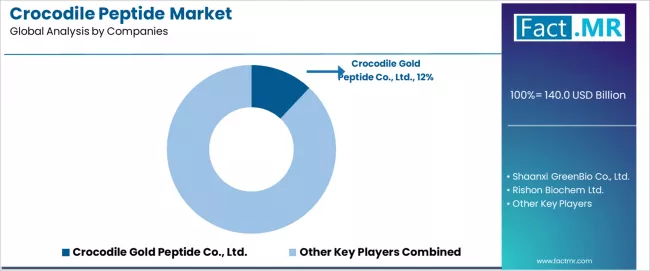
The crocodile peptide market is characterized by competition among specialized peptide manufacturers, biotechnology companies, and exotic ingredient suppliers. Companies are investing in sustainable sourcing development, extraction technology advancement, quality assurance protocols, and application research to deliver high-purity, bioactive, and ethically sourced crocodile peptide solutions. Innovation in extraction efficiency, bioactivity enhancement, and sustainable production methods is central to strengthening market position and competitive advantage.
Crocodile Gold Peptide Co. leads the market with a 12.0% share, offering specialized crocodile peptide solutions with focus on sustainable sourcing, advanced extraction methods, and comprehensive quality assurance serving premium nutraceutical and cosmetic applications. The company continues investing in research and development while expanding production capacity and technical support services.
Shaanxi GreenBio provides biotechnology-based peptide solutions with emphasis on quality and purity. Rishon Biochem specializes in bioactive peptide development and manufacturing. Lonza offers comprehensive ingredient solutions with biotechnology expertise. Givaudan focuses on specialty ingredients for cosmetic and nutraceutical applications. BioCell emphasizes collagen and peptide technologies.
Key Players in the Crocodile Peptide Market
- Crocodile Gold Peptide Co., Ltd.
- Shaanxi GreenBio Co., Ltd.
- Rishon Biochem Ltd.
- Lonza Group AG
- Givaudan S.A.
- BioCell Technology LLC
- NutraScience Labs, Inc.
- Bioiberica S.A.
- AIDP, Inc.
- Gelita AG
Scope of the Report
| Items | Values |
|---|---|
| Quantitative Units (2025) | USD 140.0 Million |
| Grade | Nutraceutical, Cosmetic, Research/Others |
| Form | Powder, Liquid |
| Distribution Channel | B2B Ingredient, Online, Specialty |
| Regions Covered | North America, Europe, Asia-Pacific, Latin America, Middle East & Africa |
| Countries Covered | USA, Mexico, Germany, France, UK, Japan, South Korea, and 40+ countries |
| Key Companies Profiled | Crocodile Gold Peptide Co., Shaanxi GreenBio, Rishon Biochem, Lonza, Givaudan, BioCell |
| Additional Attributes | Dollar sales by grade and form, regional demand trends, competitive landscape, technological advancements in peptide extraction, bioactivity validation, sustainable sourcing development, and premium application optimization |
Crocodile Peptide Market by Segments
-
Grade :
- Nutraceutical
- Cosmetic
- Research/Others
-
Form :
- Powder
- Liquid
-
Distribution Channel :
- B2B Ingredient
- Online
- Specialty
-
Region :
- North America
- United States
- Canada
- Mexico
- Europe
- Germany
- United Kingdom
- France
- Italy
- Spain
- Netherlands
- Rest of Europe
- Asia-Pacific
- Japan
- South Korea
- China
- India
- Australia
- Rest of Asia-Pacific
- Latin America
- Brazil
- Argentina
- Rest of Latin America
- Middle East & Africa
- Kingdom of Saudi Arabia
- South Africa
- Rest of Middle East & Africa
- North America
Table of Content
- Executive Summary
- Global Market Outlook
- Demand to side Trends
- Supply to side Trends
- Technology Roadmap Analysis
- Analysis and Recommendations
- Market Overview
- Market Coverage / Taxonomy
- Market Definition / Scope / Limitations
- Market Background
- Market Dynamics
- Drivers
- Restraints
- Opportunity
- Trends
- Scenario Forecast
- Demand in Optimistic Scenario
- Demand in Likely Scenario
- Demand in Conservative Scenario
- Opportunity Map Analysis
- Product Life Cycle Analysis
- Supply Chain Analysis
- Investment Feasibility Matrix
- Value Chain Analysis
- PESTLE and Porter’s Analysis
- Regulatory Landscape
- Regional Parent Market Outlook
- Production and Consumption Statistics
- Import and Export Statistics
- Market Dynamics
- Global Market Analysis 2020 to 2024 and Forecast, 2025 to 2035
- Historical Market Size Value (USD Million) Analysis, 2020 to 2024
- Current and Future Market Size Value (USD Million) Projections, 2025 to 2035
- Y to o to Y Growth Trend Analysis
- Absolute $ Opportunity Analysis
- Global Market Pricing Analysis 2020 to 2024 and Forecast 2025 to 2035
- Global Market Analysis 2020 to 2024 and Forecast 2025 to 2035, By Grade
- Introduction / Key Findings
- Historical Market Size Value (USD Million) Analysis By Grade , 2020 to 2024
- Current and Future Market Size Value (USD Million) Analysis and Forecast By Grade , 2025 to 2035
- Nutraceutical
- Cosmetic
- Research/Others
- Y to o to Y Growth Trend Analysis By Grade , 2020 to 2024
- Absolute $ Opportunity Analysis By Grade , 2025 to 2035
- Global Market Analysis 2020 to 2024 and Forecast 2025 to 2035, By Form
- Introduction / Key Findings
- Historical Market Size Value (USD Million) Analysis By Form, 2020 to 2024
- Current and Future Market Size Value (USD Million) Analysis and Forecast By Form, 2025 to 2035
- Powder
- Liquid
- Y to o to Y Growth Trend Analysis By Form, 2020 to 2024
- Absolute $ Opportunity Analysis By Form, 2025 to 2035
- Global Market Analysis 2020 to 2024 and Forecast 2025 to 2035, By Region
- Introduction
- Historical Market Size Value (USD Million) Analysis By Region, 2020 to 2024
- Current Market Size Value (USD Million) Analysis and Forecast By Region, 2025 to 2035
- North America
- Latin America
- Western Europe
- Eastern Europe
- East Asia
- South Asia and Pacific
- Middle East & Africa
- Market Attractiveness Analysis By Region
- North America Market Analysis 2020 to 2024 and Forecast 2025 to 2035, By Country
- Historical Market Size Value (USD Million) Trend Analysis By Market Taxonomy, 2020 to 2024
- Market Size Value (USD Million) Forecast By Market Taxonomy, 2025 to 2035
- By Country
- USA
- Canada
- Mexico
- By Grade
- By Form
- By Country
- Market Attractiveness Analysis
- By Country
- By Grade
- By Form
- Key Takeaways
- Latin America Market Analysis 2020 to 2024 and Forecast 2025 to 2035, By Country
- Historical Market Size Value (USD Million) Trend Analysis By Market Taxonomy, 2020 to 2024
- Market Size Value (USD Million) Forecast By Market Taxonomy, 2025 to 2035
- By Country
- Brazil
- Chile
- Rest of Latin America
- By Grade
- By Form
- By Country
- Market Attractiveness Analysis
- By Country
- By Grade
- By Form
- Key Takeaways
- Western Europe Market Analysis 2020 to 2024 and Forecast 2025 to 2035, By Country
- Historical Market Size Value (USD Million) Trend Analysis By Market Taxonomy, 2020 to 2024
- Market Size Value (USD Million) Forecast By Market Taxonomy, 2025 to 2035
- By Country
- Germany
- UK
- Italy
- Spain
- France
- Nordic
- BENELUX
- Rest of Western Europe
- By Grade
- By Form
- By Country
- Market Attractiveness Analysis
- By Country
- By Grade
- By Form
- Key Takeaways
- Eastern Europe Market Analysis 2020 to 2024 and Forecast 2025 to 2035, By Country
- Historical Market Size Value (USD Million) Trend Analysis By Market Taxonomy, 2020 to 2024
- Market Size Value (USD Million) Forecast By Market Taxonomy, 2025 to 2035
- By Country
- Russia
- Poland
- Hungary
- Balkan & Baltic
- Rest of Eastern Europe
- By Grade
- By Form
- By Country
- Market Attractiveness Analysis
- By Country
- By Grade
- By Form
- Key Takeaways
- East Asia Market Analysis 2020 to 2024 and Forecast 2025 to 2035, By Country
- Historical Market Size Value (USD Million) Trend Analysis By Market Taxonomy, 2020 to 2024
- Market Size Value (USD Million) Forecast By Market Taxonomy, 2025 to 2035
- By Country
- China
- Japan
- South Korea
- By Grade
- By Form
- By Country
- Market Attractiveness Analysis
- By Country
- By Grade
- By Form
- Key Takeaways
- South Asia and Pacific Market Analysis 2020 to 2024 and Forecast 2025 to 2035, By Country
- Historical Market Size Value (USD Million) Trend Analysis By Market Taxonomy, 2020 to 2024
- Market Size Value (USD Million) Forecast By Market Taxonomy, 2025 to 2035
- By Country
- India
- ASEAN
- Australia & New Zealand
- Rest of South Asia and Pacific
- By Grade
- By Form
- By Country
- Market Attractiveness Analysis
- By Country
- By Grade
- By Form
- Key Takeaways
- Middle East & Africa Market Analysis 2020 to 2024 and Forecast 2025 to 2035, By Country
- Historical Market Size Value (USD Million) Trend Analysis By Market Taxonomy, 2020 to 2024
- Market Size Value (USD Million) Forecast By Market Taxonomy, 2025 to 2035
- By Country
- Kingdom of Saudi Arabia
- Other GCC Countries
- Turkiye
- South Africa
- Other African Union
- Rest of Middle East & Africa
- By Grade
- By Form
- By Country
- Market Attractiveness Analysis
- By Country
- By Grade
- By Form
- Key Takeaways
- Key Countries Market Analysis
- USA
- Pricing Analysis
- Market Share Analysis, 2024
- By Grade
- By Form
- Canada
- Pricing Analysis
- Market Share Analysis, 2024
- By Grade
- By Form
- Mexico
- Pricing Analysis
- Market Share Analysis, 2024
- By Grade
- By Form
- Brazil
- Pricing Analysis
- Market Share Analysis, 2024
- By Grade
- By Form
- Chile
- Pricing Analysis
- Market Share Analysis, 2024
- By Grade
- By Form
- Germany
- Pricing Analysis
- Market Share Analysis, 2024
- By Grade
- By Form
- UK
- Pricing Analysis
- Market Share Analysis, 2024
- By Grade
- By Form
- Italy
- Pricing Analysis
- Market Share Analysis, 2024
- By Grade
- By Form
- Spain
- Pricing Analysis
- Market Share Analysis, 2024
- By Grade
- By Form
- France
- Pricing Analysis
- Market Share Analysis, 2024
- By Grade
- By Form
- India
- Pricing Analysis
- Market Share Analysis, 2024
- By Grade
- By Form
- ASEAN
- Pricing Analysis
- Market Share Analysis, 2024
- By Grade
- By Form
- Australia & New Zealand
- Pricing Analysis
- Market Share Analysis, 2024
- By Grade
- By Form
- China
- Pricing Analysis
- Market Share Analysis, 2024
- By Grade
- By Form
- Japan
- Pricing Analysis
- Market Share Analysis, 2024
- By Grade
- By Form
- South Korea
- Pricing Analysis
- Market Share Analysis, 2024
- By Grade
- By Form
- Russia
- Pricing Analysis
- Market Share Analysis, 2024
- By Grade
- By Form
- Poland
- Pricing Analysis
- Market Share Analysis, 2024
- By Grade
- By Form
- Hungary
- Pricing Analysis
- Market Share Analysis, 2024
- By Grade
- By Form
- Kingdom of Saudi Arabia
- Pricing Analysis
- Market Share Analysis, 2024
- By Grade
- By Form
- Turkiye
- Pricing Analysis
- Market Share Analysis, 2024
- By Grade
- By Form
- South Africa
- Pricing Analysis
- Market Share Analysis, 2024
- By Grade
- By Form
- USA
- Market Structure Analysis
- Competition Dashboard
- Competition Benchmarking
- Market Share Analysis of Top Players
- By Regional
- By Grade
- By Form
- Competition Analysis
- Competition Deep Dive
- Crocodile Gold Peptide Co., Ltd.
- Overview
- Product Portfolio
- Profitability by Market Segments (Product/Age /Sales Channel/Region)
- Sales Footprint
- Strategy Overview
- Marketing Strategy
- Product Strategy
- Channel Strategy
- Shaanxi GreenBio Co., Ltd.
- Rishon Biochem Ltd.
- Lonza Group AG
- Givaudan S.A.
- BioCell Technology LLC
- NutraScience Labs, Inc.
- Bioiberica S.A.
- AIDP, Inc.
- Gelita AG
- Crocodile Gold Peptide Co., Ltd.
- Competition Deep Dive
- Assumptions & Acronyms Used
- Research Methodology
List Of Table
- Table 1: Global Market Value (USD Million) Forecast by Region, 2020 to 2035
- Table 2: Global Market Value (USD Million) Forecast by Grade , 2020 to 2035
- Table 3: Global Market Value (USD Million) Forecast by Form, 2020 to 2035
- Table 4: North America Market Value (USD Million) Forecast by Country, 2020 to 2035
- Table 5: North America Market Value (USD Million) Forecast by Grade , 2020 to 2035
- Table 6: North America Market Value (USD Million) Forecast by Form, 2020 to 2035
- Table 7: Latin America Market Value (USD Million) Forecast by Country, 2020 to 2035
- Table 8: Latin America Market Value (USD Million) Forecast by Grade , 2020 to 2035
- Table 9: Latin America Market Value (USD Million) Forecast by Form, 2020 to 2035
- Table 10: Western Europe Market Value (USD Million) Forecast by Country, 2020 to 2035
- Table 11: Western Europe Market Value (USD Million) Forecast by Grade , 2020 to 2035
- Table 12: Western Europe Market Value (USD Million) Forecast by Form, 2020 to 2035
- Table 13: Eastern Europe Market Value (USD Million) Forecast by Country, 2020 to 2035
- Table 14: Eastern Europe Market Value (USD Million) Forecast by Grade , 2020 to 2035
- Table 15: Eastern Europe Market Value (USD Million) Forecast by Form, 2020 to 2035
- Table 16: East Asia Market Value (USD Million) Forecast by Country, 2020 to 2035
- Table 17: East Asia Market Value (USD Million) Forecast by Grade , 2020 to 2035
- Table 18: East Asia Market Value (USD Million) Forecast by Form, 2020 to 2035
- Table 19: South Asia and Pacific Market Value (USD Million) Forecast by Country, 2020 to 2035
- Table 20: South Asia and Pacific Market Value (USD Million) Forecast by Grade , 2020 to 2035
- Table 21: South Asia and Pacific Market Value (USD Million) Forecast by Form, 2020 to 2035
- Table 22: Middle East & Africa Market Value (USD Million) Forecast by Country, 2020 to 2035
- Table 23: Middle East & Africa Market Value (USD Million) Forecast by Grade , 2020 to 2035
- Table 24: Middle East & Africa Market Value (USD Million) Forecast by Form, 2020 to 2035
List Of Figures
- Figure 1: Global Market Pricing Analysis
- Figure 2: Global Market Value (USD Million) Forecast 2020-2035
- Figure 3: Global Market Value Share and BPS Analysis by Grade , 2025 and 2035
- Figure 4: Global Market Y to o to Y Growth Comparison by Grade , 2025-2035
- Figure 5: Global Market Attractiveness Analysis by Grade
- Figure 6: Global Market Value Share and BPS Analysis by Form, 2025 and 2035
- Figure 7: Global Market Y to o to Y Growth Comparison by Form, 2025-2035
- Figure 8: Global Market Attractiveness Analysis by Form
- Figure 9: Global Market Value (USD Million) Share and BPS Analysis by Region, 2025 and 2035
- Figure 10: Global Market Y to o to Y Growth Comparison by Region, 2025-2035
- Figure 11: Global Market Attractiveness Analysis by Region
- Figure 12: North America Market Incremental Dollar Opportunity, 2025-2035
- Figure 13: Latin America Market Incremental Dollar Opportunity, 2025-2035
- Figure 14: Western Europe Market Incremental Dollar Opportunity, 2025-2035
- Figure 15: Eastern Europe Market Incremental Dollar Opportunity, 2025-2035
- Figure 16: East Asia Market Incremental Dollar Opportunity, 2025-2035
- Figure 17: South Asia and Pacific Market Incremental Dollar Opportunity, 2025-2035
- Figure 18: Middle East & Africa Market Incremental Dollar Opportunity, 2025-2035
- Figure 19: North America Market Value Share and BPS Analysis by Country, 2025 and 2035
- Figure 20: North America Market Value Share and BPS Analysis by Grade , 2025 and 2035
- Figure 21: North America Market Y to o to Y Growth Comparison by Grade , 2025-2035
- Figure 22: North America Market Attractiveness Analysis by Grade
- Figure 23: North America Market Value Share and BPS Analysis by Form, 2025 and 2035
- Figure 24: North America Market Y to o to Y Growth Comparison by Form, 2025-2035
- Figure 25: North America Market Attractiveness Analysis by Form
- Figure 26: Latin America Market Value Share and BPS Analysis by Country, 2025 and 2035
- Figure 27: Latin America Market Value Share and BPS Analysis by Grade , 2025 and 2035
- Figure 28: Latin America Market Y to o to Y Growth Comparison by Grade , 2025-2035
- Figure 29: Latin America Market Attractiveness Analysis by Grade
- Figure 30: Latin America Market Value Share and BPS Analysis by Form, 2025 and 2035
- Figure 31: Latin America Market Y to o to Y Growth Comparison by Form, 2025-2035
- Figure 32: Latin America Market Attractiveness Analysis by Form
- Figure 33: Western Europe Market Value Share and BPS Analysis by Country, 2025 and 2035
- Figure 34: Western Europe Market Value Share and BPS Analysis by Grade , 2025 and 2035
- Figure 35: Western Europe Market Y to o to Y Growth Comparison by Grade , 2025-2035
- Figure 36: Western Europe Market Attractiveness Analysis by Grade
- Figure 37: Western Europe Market Value Share and BPS Analysis by Form, 2025 and 2035
- Figure 38: Western Europe Market Y to o to Y Growth Comparison by Form, 2025-2035
- Figure 39: Western Europe Market Attractiveness Analysis by Form
- Figure 40: Eastern Europe Market Value Share and BPS Analysis by Country, 2025 and 2035
- Figure 41: Eastern Europe Market Value Share and BPS Analysis by Grade , 2025 and 2035
- Figure 42: Eastern Europe Market Y to o to Y Growth Comparison by Grade , 2025-2035
- Figure 43: Eastern Europe Market Attractiveness Analysis by Grade
- Figure 44: Eastern Europe Market Value Share and BPS Analysis by Form, 2025 and 2035
- Figure 45: Eastern Europe Market Y to o to Y Growth Comparison by Form, 2025-2035
- Figure 46: Eastern Europe Market Attractiveness Analysis by Form
- Figure 47: East Asia Market Value Share and BPS Analysis by Country, 2025 and 2035
- Figure 48: East Asia Market Value Share and BPS Analysis by Grade , 2025 and 2035
- Figure 49: East Asia Market Y to o to Y Growth Comparison by Grade , 2025-2035
- Figure 50: East Asia Market Attractiveness Analysis by Grade
- Figure 51: East Asia Market Value Share and BPS Analysis by Form, 2025 and 2035
- Figure 52: East Asia Market Y to o to Y Growth Comparison by Form, 2025-2035
- Figure 53: East Asia Market Attractiveness Analysis by Form
- Figure 54: South Asia and Pacific Market Value Share and BPS Analysis by Country, 2025 and 2035
- Figure 55: South Asia and Pacific Market Value Share and BPS Analysis by Grade , 2025 and 2035
- Figure 56: South Asia and Pacific Market Y to o to Y Growth Comparison by Grade , 2025-2035
- Figure 57: South Asia and Pacific Market Attractiveness Analysis by Grade
- Figure 58: South Asia and Pacific Market Value Share and BPS Analysis by Form, 2025 and 2035
- Figure 59: South Asia and Pacific Market Y to o to Y Growth Comparison by Form, 2025-2035
- Figure 60: South Asia and Pacific Market Attractiveness Analysis by Form
- Figure 61: Middle East & Africa Market Value Share and BPS Analysis by Country, 2025 and 2035
- Figure 62: Middle East & Africa Market Value Share and BPS Analysis by Grade , 2025 and 2035
- Figure 63: Middle East & Africa Market Y to o to Y Growth Comparison by Grade , 2025-2035
- Figure 64: Middle East & Africa Market Attractiveness Analysis by Grade
- Figure 65: Middle East & Africa Market Value Share and BPS Analysis by Form, 2025 and 2035
- Figure 66: Middle East & Africa Market Y to o to Y Growth Comparison by Form, 2025-2035
- Figure 67: Middle East & Africa Market Attractiveness Analysis by Form
- Figure 68: Global Market - Tier Structure Analysis
- Figure 69: Global Market - Company Share Analysis
- FAQs -
How big is the crocodile peptide market in 2025?
The global crocodile peptide market is estimated to be valued at USD 140.0 billion in 2025.
What will be the size of crocodile peptide market in 2035?
The market size for the crocodile peptide market is projected to reach USD 290.0 billion by 2035.
How much will be the crocodile peptide market growth between 2025 and 2035?
The crocodile peptide market is expected to grow at a 7.6% CAGR between 2025 and 2035.
What are the key product types in the crocodile peptide market?
The key product types in crocodile peptide market are nutraceutical, cosmetic and research/others.
Which form segment to contribute significant share in the crocodile peptide market in 2025?
In terms of form, powder segment to command 64.0% share in the crocodile peptide market in 2025.